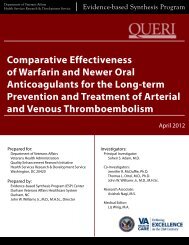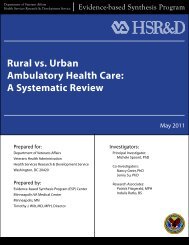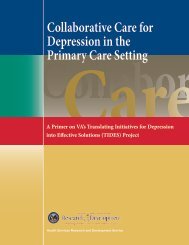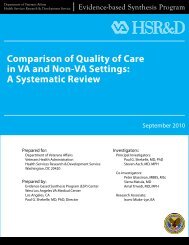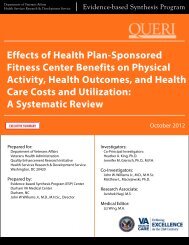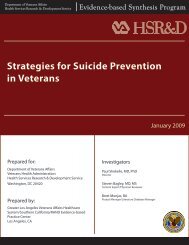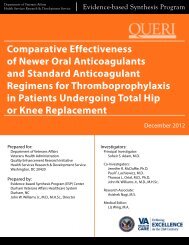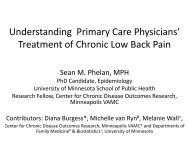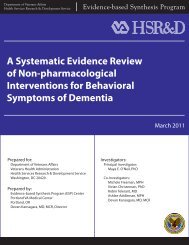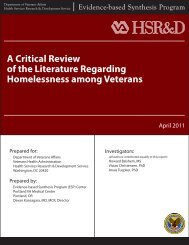VHA Systems Redesign; Transformational change in health care ...
VHA Systems Redesign; Transformational change in health care ...
VHA Systems Redesign; Transformational change in health care ...
You also want an ePaper? Increase the reach of your titles
YUMPU automatically turns print PDFs into web optimized ePapers that Google loves.
310 Health Care Management REVIEW<br />
October–December 2007<br />
F<strong>in</strong>d<strong>in</strong>gs: Five <strong>in</strong>teractive elements appear critical to successful transformation of patient <strong>care</strong>: (1) Impetus to<br />
transform; (2) Leadership commitment to quality; (3) Improvement <strong>in</strong>itiatives that actively engage staff <strong>in</strong><br />
mean<strong>in</strong>gful problem solv<strong>in</strong>g; (4) Alignment to achieve consistency of organization goals with resource allocation<br />
and actions at all levels of the organization; and (5) Integration to bridge traditional <strong>in</strong>tra-organizational<br />
boundaries among <strong>in</strong>dividual components. These elements drive <strong>change</strong> by affect<strong>in</strong>g the components of the<br />
complex <strong>health</strong> <strong>care</strong> organization <strong>in</strong> which they operate: (1) Mission, vision, and strategies that set its direction<br />
and priorities; (2) Culture that reflects its <strong>in</strong>formal values and norms; (3) Operational functions and processes that<br />
embody the work done <strong>in</strong> patient <strong>care</strong>; and (4) Infrastructure such as <strong>in</strong>formation technology and human<br />
resources that support the delivery of patient <strong>care</strong>. Transformation occurs over time with iterative <strong>change</strong>s be<strong>in</strong>g<br />
susta<strong>in</strong>ed and spread across the organization.<br />
Practice Implications: The conceptual model holds promise for guid<strong>in</strong>g <strong>health</strong> <strong>care</strong> organizations <strong>in</strong> their efforts<br />
to pursue the Institute of Medic<strong>in</strong>e aims of fundamental system redesign to achieve dramatically improved<br />
patient <strong>care</strong>.<br />
In 2001, the Institute of Medic<strong>in</strong>e (IOM) released<br />
the report Cross<strong>in</strong>g the Quality Chasm: A New Health<br />
System for the 21st Century. Highly critical of the<br />
U.S. <strong>health</strong> <strong>care</strong> system, the IOM argued that current<br />
systems of <strong>care</strong> fail to provide Americans with the highquality<br />
<strong>health</strong> <strong>care</strong> system they need, want, and deserve.<br />
To achieve safer, high-quality <strong>care</strong>, <strong>in</strong>tensive efforts are<br />
needed at all organizational levels to fundamentally<br />
redesign systems of <strong>care</strong> (IOM, 2001). Today <strong>in</strong> 2007,<br />
many <strong>health</strong> <strong>care</strong> systems are striv<strong>in</strong>g to respond to the<br />
challenges of the Quality Chasm. Few, however, have<br />
succeeded <strong>in</strong> mak<strong>in</strong>g substantial transformations to<br />
achieve the IOM aims. Us<strong>in</strong>g traditional quality improvement<br />
(QI) techniques, many have atta<strong>in</strong>ed shortterm<br />
improvements <strong>in</strong> targeted areas through hard work<br />
and focused attention. However, few QI efforts have<br />
yielded susta<strong>in</strong>ed system <strong>change</strong> because they were not<br />
supported by the culture and structure of the larger<br />
organization (Repenn<strong>in</strong>g & Sterman, 2001; Rondeau &<br />
Wagar, 2002). <strong>Transformational</strong> <strong>change</strong>, by contrast, is<br />
pervasive and <strong>in</strong>volves not only structures and processes<br />
but also the <strong>in</strong>herent culture and values of the <strong>health</strong><br />
<strong>care</strong> organization (NHS Institute for Innovation and<br />
Improvement, 2006).<br />
The question, then, is how can <strong>health</strong> <strong>care</strong> systems<br />
transform to provide consistently safe, high-quality <strong>care</strong><br />
for patients? We address this question by identify<strong>in</strong>g<br />
factors critical to successful system redesign, or transformation,<br />
from the experiences of 12 <strong>health</strong> <strong>care</strong> systems<br />
striv<strong>in</strong>g to provide superior—and <strong>in</strong> some cases,<br />
perfect—patient <strong>care</strong>. Our work stems from the national<br />
evaluation of the Pursu<strong>in</strong>g Perfection (P2) Program, a<br />
major <strong>in</strong>itiative of the Robert Wood Johnson Foundation<br />
(RWJF) created <strong>in</strong> 2001 <strong>in</strong> response to the Quality<br />
Chasm. P2 <strong>health</strong> <strong>care</strong> organizations sought to achieve<br />
dramatic improvements <strong>in</strong> patient outcomes by pursu<strong>in</strong>g<br />
perfection <strong>in</strong> all major <strong>care</strong> processes, with technical<br />
assistance from the Institute for Health<strong>care</strong> Improvement<br />
(IHI), the national program office for P2.<br />
The evaluation, which was aimed toward understand<strong>in</strong>g<br />
the factors that contributed to (or impeded)<br />
the <strong>health</strong> <strong>care</strong> systems’ abilities to achieve their<br />
goals, drew upon theoretical constructs and discipl<strong>in</strong>ary<br />
perspectives regard<strong>in</strong>g complex organizational <strong>change</strong><br />
(Greenhalgh, Robert, Macfarlane, Bate, & Kyriakidou,<br />
2004; Grol, Bosch, Hulscher, Eccles, & Wens<strong>in</strong>g, 2007;<br />
Poole & Van de Ven, 2004). The <strong>in</strong>itial conceptual<br />
framework was based on research on microsystem<br />
effectiveness—<strong>in</strong>clud<strong>in</strong>g concepts of communication,<br />
coord<strong>in</strong>ation, organizational culture, and management<br />
support and <strong>in</strong>volvement (Donaldson & Mohr, 2001;<br />
Nelson et al., 2002)—and on organizational diffusion of<br />
<strong>in</strong>novation (Rogers, 1995). This framework reflected<br />
IHI’s <strong>in</strong>tervention strategy to focus first on achiev<strong>in</strong>g<br />
perfect patient <strong>care</strong> <strong>in</strong> two cl<strong>in</strong>ical areas, then expand to<br />
five areas, and f<strong>in</strong>ally expand to all areas. We also used<br />
the IOM’s Quality Chasm aims (IOM, 2001) and the<br />
Malcolm’s Baldrige National Quality Program guidel<strong>in</strong>es<br />
(2005) as frames of reference because many study<br />
systems used them. The data collection strategy,<br />
however, was designed to capture key system experiences,<br />
dynamics, and learn<strong>in</strong>gs that were not necessarily<br />
emphasized <strong>in</strong> the orig<strong>in</strong>al frameworks. The factors<br />
reported here are those that emerged from the data as<br />
most important <strong>in</strong> the systems that we studied.<br />
This article offers a conceptual model for understand<strong>in</strong>g<br />
how organizations move from short-term<br />
performance improvements to susta<strong>in</strong>ed, organizationwide<br />
patient <strong>care</strong> improvements. The elements identified<br />
as critical to successful transformation have been<br />
Copyright @ Lipp<strong>in</strong>cott Williams & Wilk<strong>in</strong>s. Unauthorized reproduction of this article is prohibited.



